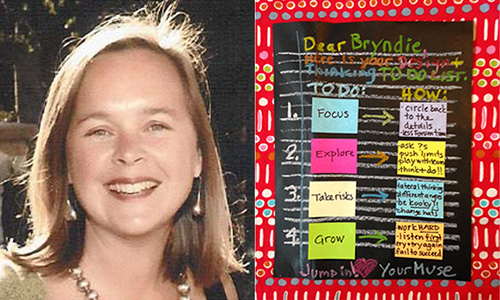The Design Thinking Action Lab online class has created the largest design team in the world, bringing together 45,000 students in fields ranging from engineering to education to business. The design thinking process helps class member Bryndie Beach use different perspectives to approach issues that she deals with as the manager of a custom home community in Carmel, California.
Read more student profiles »
by Anna Li
Bryndie Beach
Carmel, California, USA
Home Community Manager
With a doctorate in French Literature, Bryndie Beach didn’t think she’d become a fashion designer or a landscape architect and urban planner. Yet here she is, wearing many hats as the manager of a high-end, 2,000-acre custom home community in Carmel, California. She reviews architecture and design plans to make sure they follow county regulations. But she’s also interacting daily with builders, designers, homeowners and governmental agencies.
“That’s where I find the design process that the d.school started rolling out very helpful because it allows me to switch roles and really approach issues from a different perspective,” Bryndie said to me on the phone. “In terms of how I often worked in the past, I probably would have had a more ‘fix now’ and emotional response. This allows me to pull back and look at the problem from several different aspects.”
Bryndie learned about the Hasso Plattner Institute of Design, commonly called the d.school at Stanford University, last year during a Parents’ Weekend gathering with her son who is a junior attending Stanford. The interdisciplinary nature of the d.school appealed to her immediately.
Bernie Roth’s talk that weekend on Design for Extreme Affordability inspired her to help others in the developing world. The irony that Bryndie is now working for a luxury housing community with residents who are not only wealthy but also sometimes famous isn’t lost on her. She feels the tension. She grapples with the “ethical and moral balance.”
Since her introduction to design thinking, she has taken two Crash Courses on Creativity with Tina Seelig on NovoEd. Her first team was very international and included teammates from different backgrounds. Her journey with Tina helped her discover a new way to interact with her residents so she could find better solutions that satisfied homeowners without compromising the environment, which makes up the majority of the open space where the community is located.
“Empathy has helped me move into the role of the owner and understand what it’s like to want to move forward but not know how to move forward,” Bryndie said. “It was almost like stepping through the mirror and looking it at from the other side.”
In the Design Thinking Action Lab, Bryndie is focused on polishing the foundation she established through the creativity courses. She said she’s intrigued that the class is offered through the d.school and she really wants to take advantage of “design thinking skills to somehow touch upon and help solve some thorny design issues for” people “who have very little,” she wrote in a message to me.
Her plan is to focus on the process: “I wanted to see what are the mechanics to help me address things in even more detail.”
Finally, in preparation for the design challenge that Leticia released on Monday, July 29, Bryndie offered advice to people who don’t consider themselves design pros: “I saw a lot of students getting discouraged when ultra-professional and sophisticated work by professional graphic designers or other design professionals were posted on forums for ‘feedback’ and folks with fewer skills in those fields felt intimidated,” she wrote to me. “I have found that many of the most striking solutions and ideas have come from students who do not have those tech design skills and tools already in hand, so they come at the challenges from very unique and organic approaches.”
Read more student profiles »



